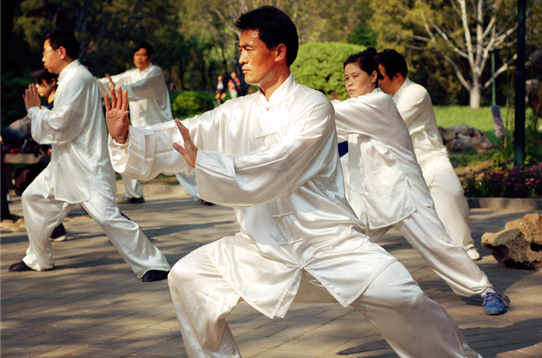With nearly 400,000 residents in the neighbourhood, Beijing Tiantongyuan is the largest community in Asia. After dinner, parks and boulevards are full of people, engaging in various forms of physical exercises-jogging, walking, practicing Tai Chi, or simply "one leg standing".
In China, such busy scenes can be found anywhere since the national fitness movement is flourishing. Do you remember one thousand people performing Tai Chi at the opening ceremony of the 2008 Beijing Olympics? This long-standing Chinese Kung Fu has been included into university PE. Both Chen-style Tai Chi with strong explosive power and Yang-style Tai Chi featured as Gang (powerful motions) hidden in Rou (slow and graceful motions) attracts thousands of followers. Tai Chi helps people adjust their breath and reach a balance in natural and smooth movements.

Not to sleep too long because long sleep impairs Qi, not to stand too long because that may hurt bones, and not to walk too long because that may injure muscles. The balanced concept of preserving health is derived from the ancient philosoph.
Sports are the best inherited heath-preserving ways. Among Qigong, martial arts and Tai Chi, some exercises are difficult to learn and some others are easy to pick up. A series of exercises "Eight Pieces of Brocade" invented in the twelfth century is easy to learn, consisting of eight parts of natural and graceful movements. Each part can help cure a kind of disease. Thirteen Measures to Keep Healthy created by Sun Simiao advises people to frequently comb hair, move eyes, massage abdomen and sway waist. These movements can be practiced anytime and at any place.
As tension should alternate with relaxation, we should pay attention to strike a balance between movement and motionlessness when preserving health through sports. Martial arts and Tai Chi are "movement", while expiration and inspiration, zazen and music, chess, calligraphy and painting are "motionless" exercises. Motionless health preservation could cheer the heart and compose the mind.

![Diseases, Symptoms, tcm, [tcmwindow.com]](/uploadFile/adImg/2015/11/11/f5cbfcc0-4df5-4646-9b9a-f316651a0199.jpg)





